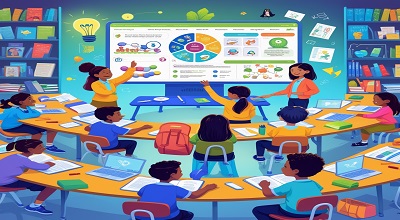Educational Software for Classrooms
Educational Software for Classrooms: In the digital age, educational software has become an essential tool in modern classrooms. These tools enhance teaching efficiency, engage students, and personalize learning experiences. From Learning Management Systems (LMS) to gamified learning platforms, schools worldwide are adopting innovative software to improve education.
Benefits of Educational Software in Classrooms
Educational software offers numerous advantages:
- Personalized Learning: Adapts to individual student needs.
- Increased Engagement: Interactive tools make learning fun.
- Efficient Assessment: Instant feedback and analytics.
- Collaboration: Facilitates group projects and discussions.
- Accessibility: Supports remote and hybrid learning.
- Cost-Effective: Reduces the need for physical materials.
Types of Educational Software
| Type | Description | Examples |
|---|---|---|
| LMS | Manages course content, assignments, and grading | Google Classroom, Moodle, Canvas |
| Interactive Whiteboard | Digital boards for interactive lessons | SMART Notebook, Explain Everything |
| Gamified Learning | Game-based learning platforms | Kahoot!, Prodigy, Duolingo |
| Adaptive Learning | AI-driven personalized learning | DreamBox, Khan Academy |
| Collaboration Tools | Facilitates group work and communication | Microsoft Teams, Slack, Padlet |
| Assessment Software | Quizzes and automated grading | Quizlet, Socrative, Edulastic |
| VR/AR Tools | Immersive learning experiences | Nearpod VR, Google Expeditions |
| Coding & STEM | Teaches programming and science | Scratch, Tinkercad, Code.org |
Latest Educational Software for Classrooms (2025)
A. Learning Management Systems (LMS)
- Google Classroom: Free, integrates with Google Workspace.
- Canvas: Used by universities for course management.
- Schoology: Combines LMS with social learning features.
B. Interactive Whiteboard Software
- SMART Notebook: Enhances lessons with drag-and-drop activities.
- Explain Everything: Cloud-based whiteboard for real-time collaboration.
C. Gamified Learning Platforms
- Kahoot!: Quiz-based competitive learning.
- Prodigy Math: Math learning through RPG games.
D. Adaptive Learning Software
- DreamBox: AI adjusts math problems based on student level.
- Khan Academy: Free, personalized learning paths.
E. Collaboration Tools
- Microsoft Teams: Video calls, assignments, and file sharing.
- Padlet: Digital bulletin board for brainstorming.
F. Assessment & Quiz Platforms
- Quizlet: Flashcards and study games.
- Edulastic: Real-time student performance tracking.
G. Virtual Reality (VR) & Augmented Reality (AR) Tools
- Nearpod VR: Virtual field trips and 3D lessons.
- Merge EDU: Hands-on STEM learning with AR.
H. Coding & STEM Education Software
- Scratch: MIT’s block-based coding for kids.
- Tinkercad: 3D design and circuit simulations.
How to Choose the Right Educational Software?
Consider these factors:
✅ Ease of Use: Teacher and student-friendly interface.
✅ Compatibility: Works with existing devices.
✅ Cost: Free vs. premium features.
✅ Scalability: Suitable for different grade levels.
✅ Support & Training: Availability of tutorials and customer service.
Case Studies: Schools Using Educational Software Successfully
- Case Study 1: A school improved math scores by 20% using Prodigy.
- Case Study 2: A university streamlined course delivery with Canvas.
Challenges and Solutions in Implementing Educational Software
| Challenge | Solution |
|---|---|
| Resistance to Change | Provide teacher training sessions. |
| Technical Issues | Ensure IT support and reliable infrastructure. |
| Budget Constraints | Use free or open-source alternatives. |
Future Trends in Classroom Educational Software
- AI-Powered Tutors: More personalized learning.
- Blockchain for Credentials: Secure digital certifications.
- Metaverse Classrooms: Virtual reality learning spaces.
Conclusion
Educational software is transforming classrooms by making learning interactive, personalized, and efficient. By selecting the right tools, schools can enhance student engagement and academic performance.
FAQs
Q1: What is the best free educational software for classrooms?
A: Google Classroom, Khan Academy, and Scratch are excellent free options.
Q2: How does adaptive learning software work?
A: It uses AI to adjust content based on student performance.
Q3: Can gamified learning improve student engagement?
A: Yes, platforms like Kahoot! and Prodigy make learning fun and interactive.
Q4: What are the risks of using educational software?
A: Privacy concerns and over-reliance on technology are potential risks.
Q5: How can teachers get training on new educational software?
A: Many platforms offer tutorials, webinars, and professional development courses.
Free Download: GO88 Club APK
